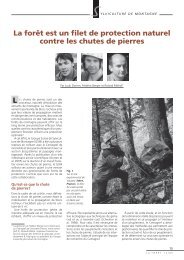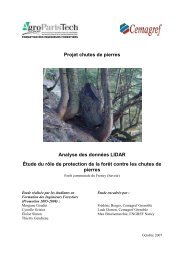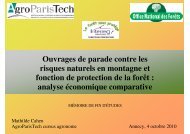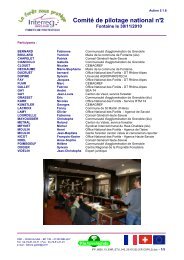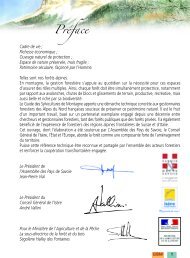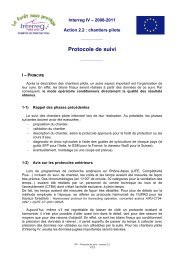Selvicoltura nelle foreste di protezione - INTERREG Forêts de ...
Selvicoltura nelle foreste di protezione - INTERREG Forêts de ...
Selvicoltura nelle foreste di protezione - INTERREG Forêts de ...
Create successful ePaper yourself
Turn your PDF publications into a flip-book with our unique Google optimized e-Paper software.
meno pronunciato <strong>di</strong> giorno e il raffreddamento è minore<br />
durante la notte rispetto a quanto si registra su terreno aperto.<br />
La foresta genera anche un regime climatico particolare che<br />
influenza i metamorfismi <strong>de</strong>lla neve: la formazione <strong>di</strong> strati <strong>di</strong><br />
ghiaccio <strong>di</strong> superficie e <strong>di</strong> profon<strong>di</strong>tà è particolarmente <strong>de</strong>bole.<br />
La minore escursione termica favorisce la formazione <strong>di</strong> bassi<br />
gra<strong>di</strong>enti all’interno <strong>de</strong>l manto nevoso, con effetti positivi<br />
sulla sua stabilizzazione. È tuttavia possibile la formazione <strong>di</strong><br />
piccole valanghe in caso <strong>di</strong> neve umida, mentre su suolo privo<br />
<strong>di</strong> scabrezza si possono osservare <strong>de</strong>gli scivolamenti.<br />
• In foresta la velocità <strong>de</strong>l vento è inferiore, pertanto anche<br />
l’accumulo sarà limitato. Accumuli <strong>di</strong> neve si possono avere<br />
invece <strong>nelle</strong> radure e ai margini <strong>de</strong>l bosco.<br />
• I tronchi e le ceppaie, così come gli alberi al suolo, aumentano la<br />
rugosità <strong>de</strong>l terreno e sono elementi stabilizzanti <strong>de</strong>l manto<br />
nevoso, riducendo la possibilità <strong>di</strong> scivolamento <strong>de</strong>lla neve.<br />
L’effetto stabilizzante <strong>de</strong>gli alberi non è generalmente sufficiente<br />
a fermare il <strong>di</strong>stacco <strong>di</strong> valanghe; il fattore che invece favorisce il<br />
<strong>di</strong>stacco <strong>di</strong> valanghe in foresta è la formazione <strong>di</strong> importanti strati <strong>di</strong><br />
Figura 6.2<br />
Schema <strong>de</strong>l processo <strong>di</strong> <strong>de</strong>posito <strong>de</strong>lla neve in foresta (da Meyer 1987 e Cemagref)<br />
Deposito<br />
<strong>di</strong>retto<br />
Per<strong>di</strong>te per intercettazione(evapotraspirazione<br />
e vento)<br />
Intercettazione =<br />
<strong>de</strong>positi provvisori<br />
Caduta<br />
<strong>di</strong>fferita<br />
Nevicata<br />
Deposito<br />
<strong>di</strong>retto<br />
Caduta<br />
<strong>di</strong>fferita <strong>de</strong>lla<br />
neve e<br />
accumulo<br />
verso il basso<br />
Neve trasportata dal<br />
vento e formazione<br />
<strong>di</strong> turbolenze<br />
Deposito<br />
supplementare<br />
75



